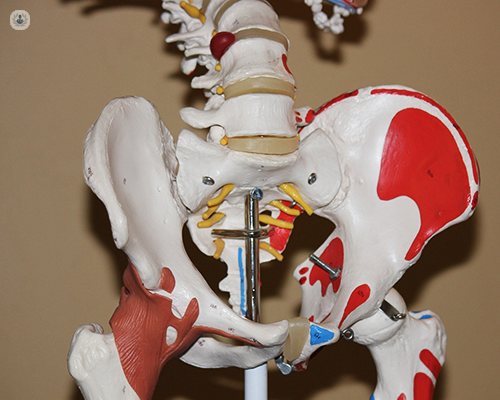Hip replacement: what are my options?
Autore:What are the different types of hip replacements available?
There are lots of different types of hip replacements, which are customised for patients based on their needs.
There are different ways of classifying hip replacements, however many orthopaedic surgeons classify them as standard knee replacements, for standard day to day needs or a high demand hip replacements, referring to hip replacments for patients who have higher needs. These higher needs could be that the patients are still active in sports, that they do extreme sports or they are extremely active in their day to day life.
The conventional way of classifying hip replacement is firstly in terms of how they are fixed i.e whether the replacement is a cemented hip or uncemented hip or if it is a combination of both.

The second way of classifying a hip replacment is the type of material used in the hip replacement.
There are two different types of hip replacement.
One is how doctors fix the hip in your body. One way is to use bone cement, which is used to fix the components of the hip joint. There are two components of the hip joint. One is the cup and the other is the stem. Doctors can cement either one, or both of these, depending on the bone quality.
The second way of fixing the components is if it is uncemented (when bone cement is not used). The way these uncemented hips work is that they have special coating, meaning the bone will grow onto these components and they become a part of the body.
Another option is hybrid, when one component is cemented and the other component isn’t cemented.
A standard conventional hip replacement is made up of a metal ball and a plastic liner. The other options available for the surgeon to use are a cermaic head on a special plastic liner or something known as highly cross-linked polyethylene.The other option is head on a ceramic liner.
There is another option available called metal on metal hips, which is metal ball on a metal liner. This is not widely used nowadays because of the problems associated with it.
A metal on a ceramic or a ceramic on a plastic is generally used. The surgeon will determine what is the best hip replacement for you .
What factors affect which hip replacement method is chosen?
One of the most important factors is the patients age; their physiological age, referring to how fit and active they are.
Another factor is quality of life; if the patient engages in any sporting activity.
In addition, bone quality is a determining factor. When surgeons perform an x-ray or a CT scan of the hip, they want to check the bone quality of the hip, the cup or the stem of the femur. This will determine what sort of hip will be best for the patient in terms of fixation techniques.
If someone is quite physiologically young and active, a high demand hip is quite useful. In cases like this, surgeons tend to use an uncemented hip with a ceramic head on a special plastic liner which is highly cross-linked polyethylene.
On the other hand, if someone is reasonably old, low demand patient, surgeons expect to eliminate arthritis of the hip, therefore a conventional hip replacement, with a metal head of any type of plastic liner is sufficient.
It is important to note that as we get older, our bone structure and quality gets weaker and poor. In such cases, cement is used for fixation because after a hip replacement, doctors want the patient to be mobile straight away, with the ability to walk on it straight away. If the bone is weak and suregons feel that the bone quality is poor during the operation, they will use cement to gain fixation.
What factors affect which hip replacement method is chosen?
One of the most important factors is the patients age; their physiological age, referring to how fit and active they are.
Another factor is quality of life; if the patient engages in any sporting activity.
In addition, bone quality is a determining factor. When surgeons perform an x-ray or a CT scan of the hip, they want to check the bone quality of the hip, the cup or the stem of the femur. This will determine what sort of hip will be best for the patient in terms of fixation techniques.
If someone is quite physiologically young and active, a high demand hip is quite useful. In cases like this, surgeons tend to use an uncemented hip with a ceramic head on a special plastic liner which is highly cross-linked polyethylene.
On the other hand, if someone is reasonably old, low demand patient, surgeons expect to eliminate arthritis of the hip, therefore a conventional hip replacement, with a metal head of any type of plastic liner is sufficient.
It is important to note that as we get older, our bone structure and quality gets weaker and poor. In such cases, cement is used for fixation because after a hip replacement, doctors want the patient to be mobile straight away, with the ability to walk on it straight away. If the bone is weak and suregons feel that the bone quality is poor during the operation, they will use cement to gain fixation.
How is the best type of hip replacement chosen for a patient?
Hip replacement is usually customised for each individual because many different types of hips or a combination of hips can be used for different patients.
For those who are extremely active and want to continue with sports and active life even after hip replacement, doctors usually have a certain criteria. They may want to use the largest head of the artificial hip possible to gain extra stability.
The best bearing available for this is the ceramic head. They will also want to use a good, uncemented stem which is made of titanium and coated with hydroxyapatite. The stem grows into the bone and becomes part of your body.
The cup or socket is determined by bone quality. Doctors tend touse a combination of either cemented or uncemented depending on the bone quality as determined during the surgery.
In lower demand patients, or where the bone structure is not strong, a fully cemented hip is often used.
In terms of the head size, generally, a larger head is better; whatever is better for the stability of the hip joint.
However 32mm is the head size used in most cases or 28mm in some cases. A larger hip could wear out the hip too much or quicker so 36mm head is only used in some cases.
If a revision replacement is required, is a different method chosen?
The average lifespan of hip replacement is around 15 years in 90-95% of cases.
A revision may be needed if the hip comes loose. If cement has been used, it can crack and come loose, or the components start to wear out. With a plastic liner, it can start to wear out therefore the hip can start to become loose.
Patients may feel that the hip has functioned well for over 15 years but then it starts to become painful so then it may require some futher surgery.
The hip may need to be replaced if it starts to dislocate, become unstable or if an infection has been developed or any other problems related to the hip.
Revision surgery is in two main components. The first step is to eliminate old components, i.e. the stem or the cup or both depending on what the problem is and replace them. Surgeons change these components depending on the need to do something more robust or for longer e.g. if a sample length stem which is loose, they insert a sample length stem to reinforce the fixation.
Hip surgery is customised to every case. No two cases are the same. It depends on the patient’s fitness, the bone stock and the reason why it’s being replaced.


